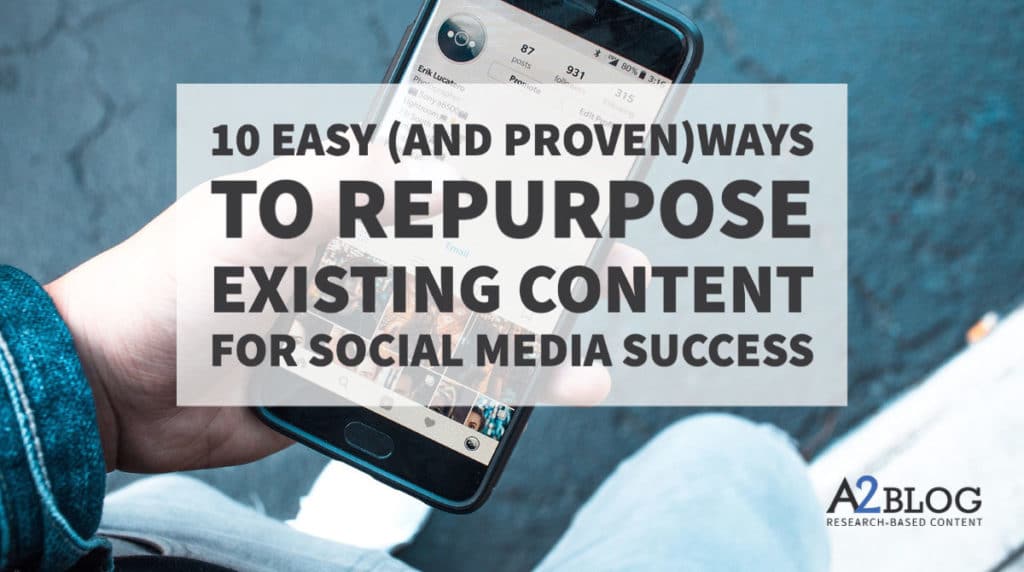
Guest post provided by: Priyanka Desai
If you’ve ever struggled to come up with killer social media posts, you’ll understand the value of repurposing content.
Content marketers and social media teams understand the struggle of creating fresh social media content day in and out. Let’s admit, generating multiple, high-converting ideas for multiple accounts is like running uphill with a backpack on!
The Ascend2 study, Building Thought Leadership with Content, found that marketers are challenged by both the quality and quantity of content that is required to execute a successful content marketing program. So when you have great content, you want to use it as much as possible.

Have you ever posted a Tweet that resulted in a surge of likes, comments, and re-tweets and you didn’t want it to fade away?
Or you posted an amazing photo on Facebook that had great quality and then wondered how to replicate that success with other content and on other channels?
Well, things get easier when you put a fresh spin instead of trying to reinvent the wheel. And, that’s what content repurposing and recycling is all about.
In this blog post, let’s deep dive into repurposing content on social media. To keep your calendar full, your content cycling, and your audience engaged, here are some content repurposing examples and strategies.
What is content repurposing for social media?
Repurposing content is the process of taking content you’ve already created and tweaking it to reuse in another format.
Do you have an original research piece that has generated a lot of interest and engagement? Do you have a LinkedIn post that got plenty of traction? Or that you were proud of? You could turn it into a YouTube video, in-depth blog post, or a Twitter thread.
You can also do a follow-up with another LinkedIn post, convert it into a video for LinkedIn or create a more visual LinkedIn post. In short, you can even repurpose content on the same platform.
A great idea shouldn’t end with a single post. Social media content repurposing keeps your calendar full and your audiences engaged. You wouldn’t run out of ideas on what to post.
Why is content repurposing so important for marketers?
For the busy content marketer, learning how to repurpose content is a gamechanger.
This is all the truer when you’re a small team managing content, SEO, social media, and other aspects of marketing.
Or suppose you are a social media agency relying on clients to pass information about products or services and the flow of material is restricted. How can you repurpose a single set of photos in several ways to keep your social media calendar full without boring the audience?
Knowing how to repurpose content can make a huge impact on the work you do, with an improved success rate.
10 Strategies for repurposing content on social media
Now that you’ve seen the appeal of rehashing existing content, let’s look at the 10 strategies of how you can repurpose content.
#1. Adapting content for cross-platform sharing
Great content should be shared across multiple platforms.
Have a great blog post, original research report, or a long-form content piece? Post it everywhere.
Although you can post the same content on multiple social media platforms, you should customize it for each platform.
For instance, while repurposing content, remember, Facebook posts should not have hashtags. On the other hand, tweets should have a few hashtags, And Instagram posts have many hashtags.
While posting content on Twitter, you will need to be more concise as opposed to LinkedIn where you could post longer content.
Content on Instagram and Pinterest requires high-quality images.
You can take a single concept and image and repurpose it in different ways.
Here’s how LeadSquared, a sales execution CRM and marketing automation software shares product updates on LinkedIn.
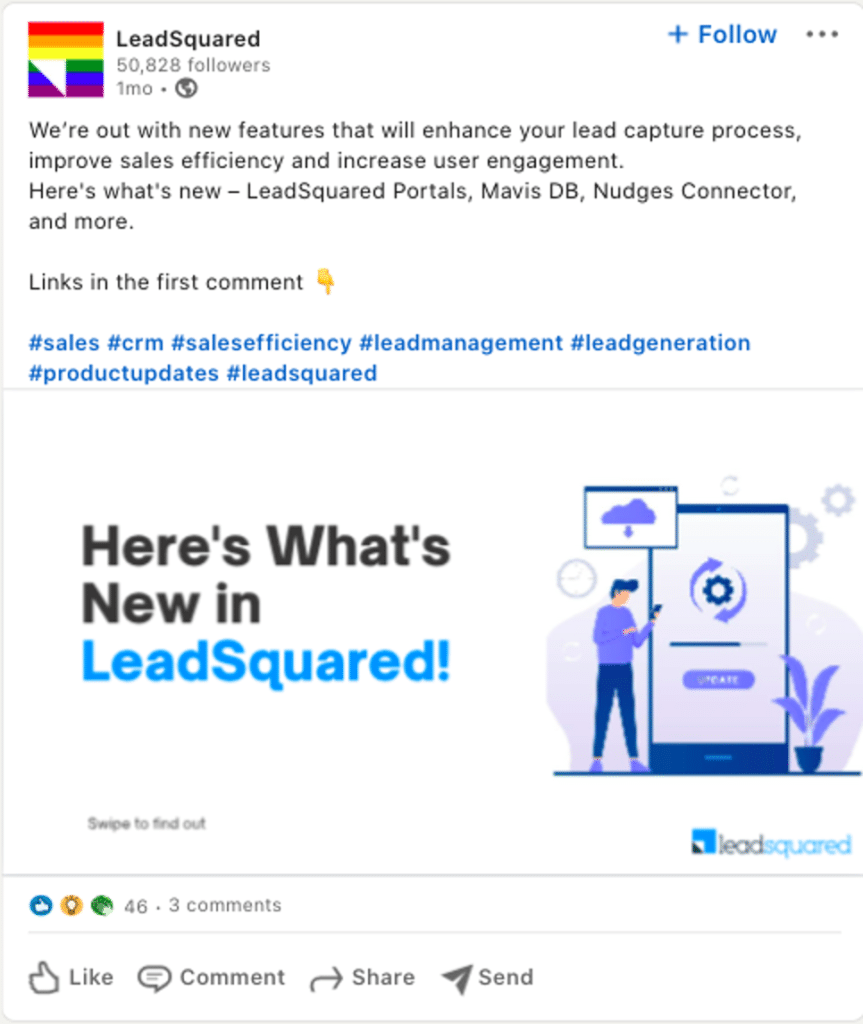
Possibly, your audience may need a reminder often about the product features. Or when you’ve launched a new feature, along with adding it to the website, you could share it on social media in different content types relevant to each platform.
#2. Revamp high-performing blog posts
Remember, repurposing social media content does not mean copying and pasting great statuses.
Instead, when you share the content that worked so well, update it.
You’re more likely to get stronger results on your second campaign if you create new versions of your original content than posting the exact duplicate multiple times.
Some examples of repurposing blog posts are:
- Pull several different images, statistics, or quotes from the blog posts, videos, or interviews you are sharing. Every time you share content on social media, use a different quote. This could be a quote from an industry influencer that can help you drive clicks across several posts even when you’re sharing a single resource.
- Compile user-generated content (UGC) or testimonial from the website, blog post, or newsletter that you can then promote with visuals. By placing it in a new format, you can make that content more impactful for a new set of audiences.
- Updating older high-performing posts with the latest information and announcing in your social media posts.
- Sharing your posts over Instagram Stories, Twitter moments, and LinkedIn stories to capture more attention and drive more engagement.
One of my favorite examples is SuperOffice CRM – which has detailed, insightful, and updated blog posts. Each article has the latest statistics and visuals that make the posts fresh and relevant.
For example, this article “7 ways to create a great customer experience strategy” was originally published 6 years ago and last refreshed in May 2021 with the latest statistics based on a recent survey conducted by SuperOffice.
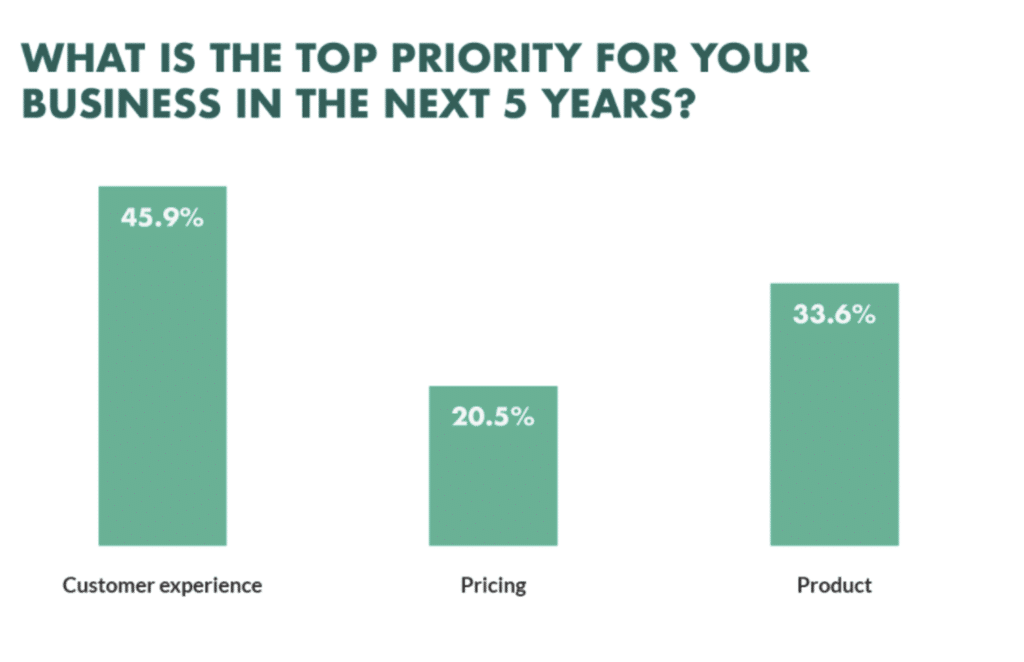
In a nutshell, from the 5 effective content marketing types used to grow your business including blogging, podcasts, video marketing, case studies, and user-generated content, you can repurpose each of them on social media.
#3. Reusing visuals creatively
There’s nothing better than repurposing images to get the most life out of them.
Let’s take a simple example from the Twitter handle of Ben and Jerry’s ice cream brand.

As seen in this example, you can use the same picture for multiple posts, overlaid onto a new background. A text overlay along with some graphics would breathe new life into a visual.
Graphic design software can help you use and update existing images.
Alternatively, you can combine still video images into a comprehensive video with tools like Promo and Clipchamp to shake things up. These videos can then be used to promote testimonials, sales, and new product releases in the form of videos in your feed and stories.
#4. Converting static posts into dynamic experiences
By now, I know you may be tired of hearing the words “dynamic” and “interactive”, but they are important.
To get results, you must determine what you can do to create interactive experiences that stop the users from scrolling down and get them talking to you. Or listening to you.
As a user, what would you remember more? A post on Facebook or a notification that a small business CEO is answering questions on Facebook Live?
The other way to go about it is, if you have an evergreen blog post, make a podcast out of it and promote it on social media channels. Chances are, not all your readers would have the time to go through lengthy posts. They might rather listen to the insights on the go. You can then post them on podcast-sharing platforms like Anchor, or Apple Podcasts.
Business analytics platform Databox is one of the best examples. One of their interviews on personalized onboarding videos with Bonjoro’s head of growth was published in the form of a blog post. They have an option where audiences can listen to the interview.
And the same interview is condensed in the form of a video that’s posted on LinkedIn.
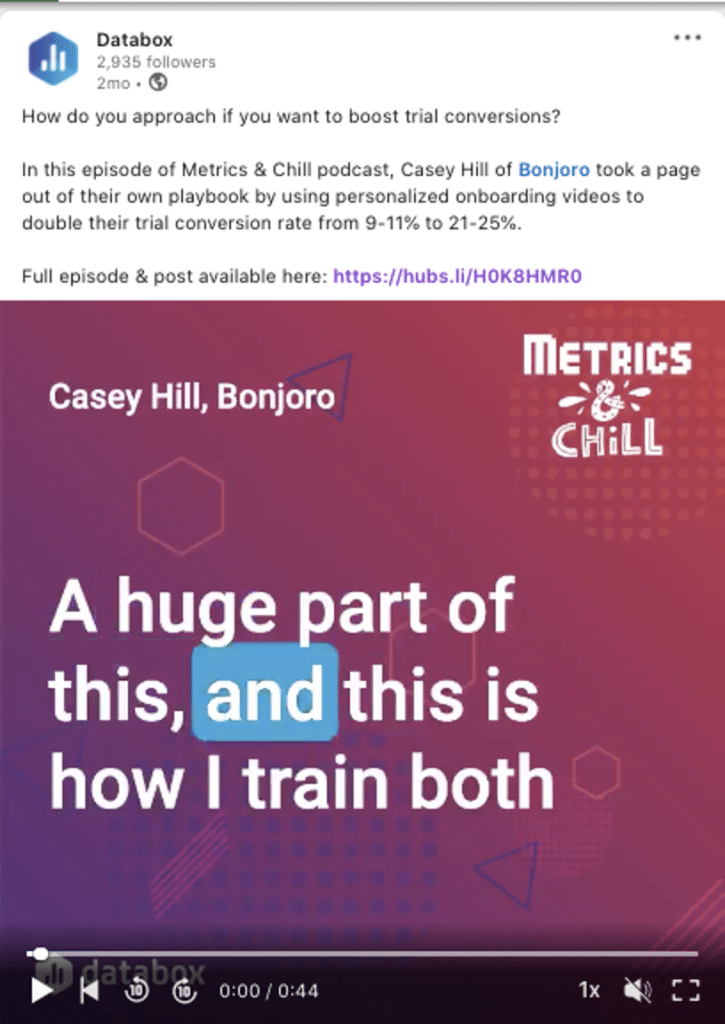
When you have a great piece of content, why not reuse it for video, audio, and article readers.
Video customer experience platform HippoVideo regularly shares video interviews on their LinkedIn platform. Apart from the 1-minute snippet, if you want to follow the topic in detail, you can click on the link to Spotify and Apple Podcast.
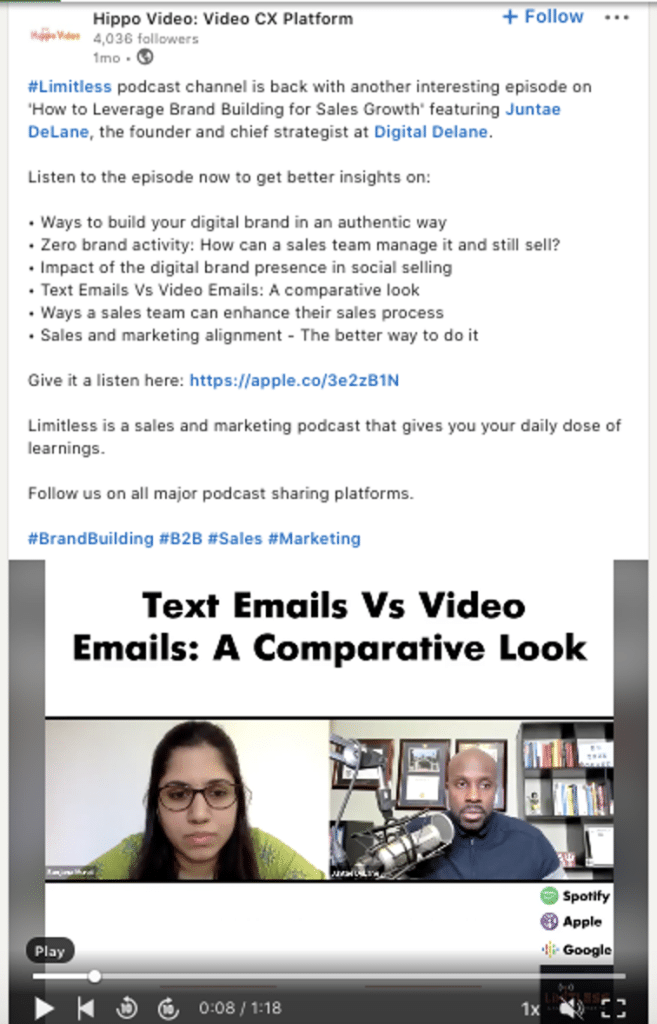
In short, interactive content helps increase brand awareness, including engagement, retention of data, and conversions.
#5. Transform webinars into video tutorials
Was your recent webinar a real success?
Of course, not everyone who signed up or showed interest was able to attend. That’s why, to bring your webinar to as many people as possible, you need to convert the webinar into a YouTube video. The other option is to make short videos of the best parts or takeaways and post them on social media to drive new visitors to the YouTube video. Boosting your content with a video marketing strategy is a clever move, as video becomes the de-facto mode of content consumption.
LiveWebinar and LearnWorlds conducted an online webinar titled “The power of the webinar: How to teach live classes and sell more courses.” The same webinar was posted on YouTube for readers who wanted to refer back to the video content.

When you distribute these video or audio snippets on Facebook, LinkedIn, and other social media channels, you increase the chances of having more attendees at your future webinars.
Social media management tools like Bulk.ly, SocialPilot, and Falcon can help you optimize the best time to post your content on different social media platforms.
#6. Re-share great content with a timely spin
If you’ve been a marketer for a few years, you know the dread of writer’s block. While initially, it is fun and easy to come up with exciting content for a brand, when you undergo the creative block, coming up with new content for social media marketing becomes a task in itself.
The good news is, there are always timely and relevant events impacting your industry. They allow you to repurpose content interestingly.
Every year, brands put out “What are you doing for summer” or “Our summer collection” posts on social media.
Misfits Market, for example, applied a twist to the standard (and boring) format. Their posts highlight that the Covid-19 vaccines are rolling out, the world is opening up and they want to know the customer’s travel and summer plans.
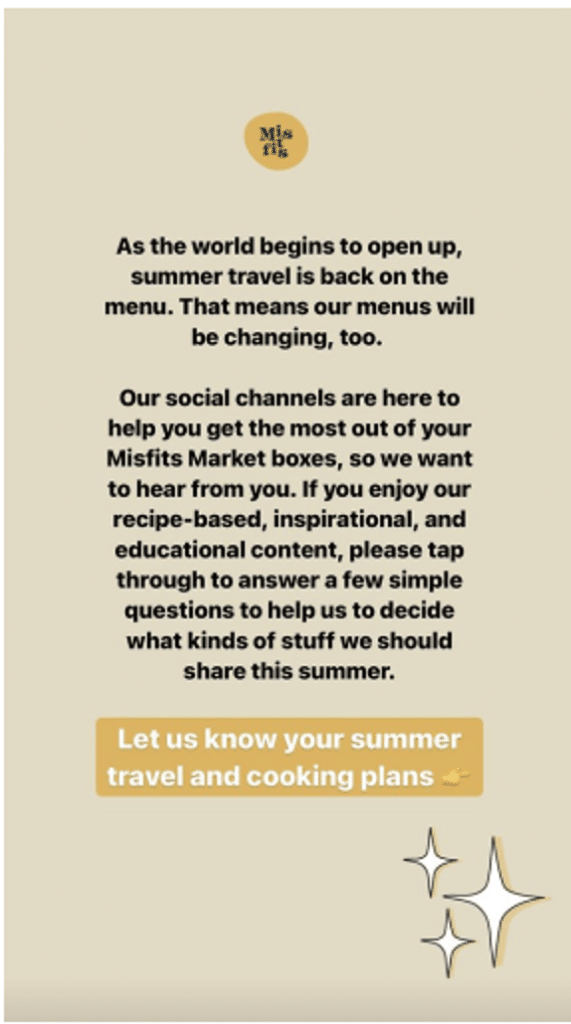
If you ask me, this is a smart way to ask what the customers are excited about while adapting a standard topic into something interesting.
#7. Creating a series of blog posts from a single idea
If you’ve come up with a report or curated statistics, they become the best content format to repurpose.
You can create a series of posts from a single idea, topic, or resource. They can help you get more eyes on a content topic or resource you want to promote.
Online video analytics platform Vidooly shares reports on video, OTT, and advertising trends. Their report “Podcasting Industry in India” has tons of data-backed insights that are shared in the form of visuals on LinkedIn and Twitter.

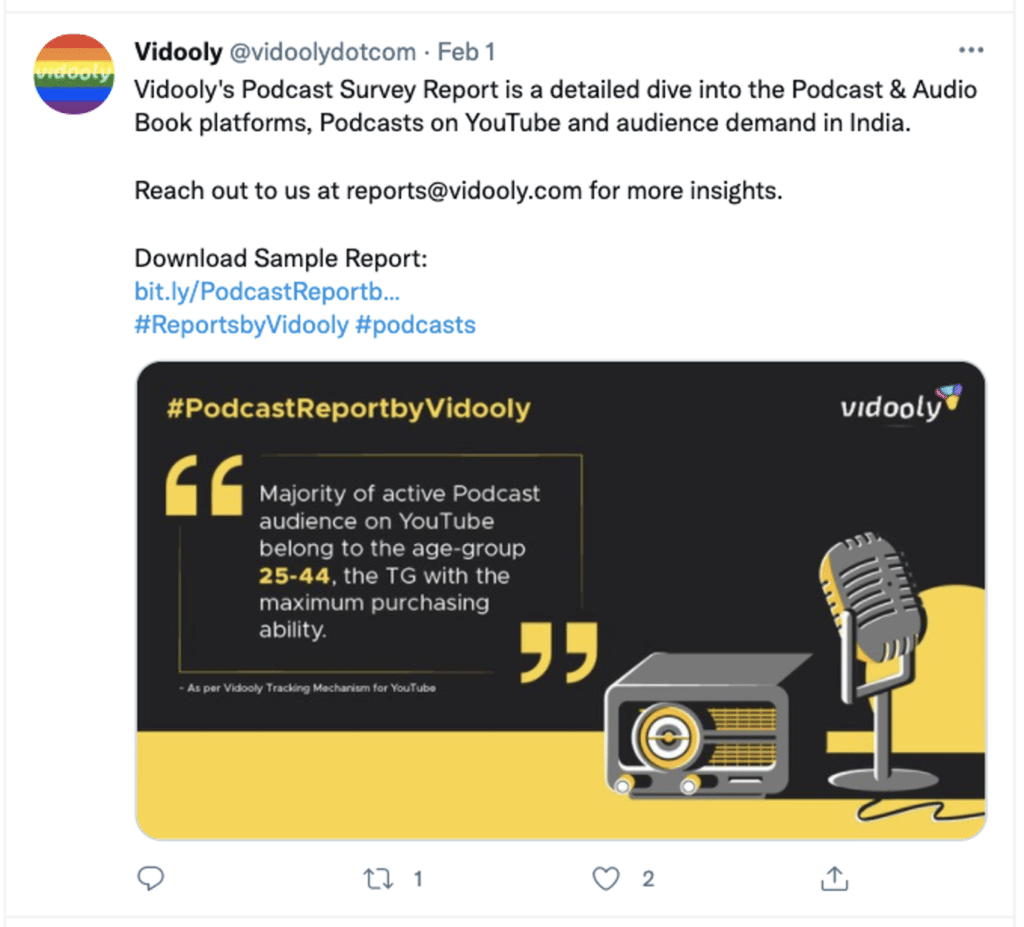
#8. Creating Twitter threads
Believe it or not, every marketer has tons of learnings and insights, based on experience. You can put them in the form of a Twitter thread.
Here’s an example of marketer Ross Simmond’s Twitter thread.
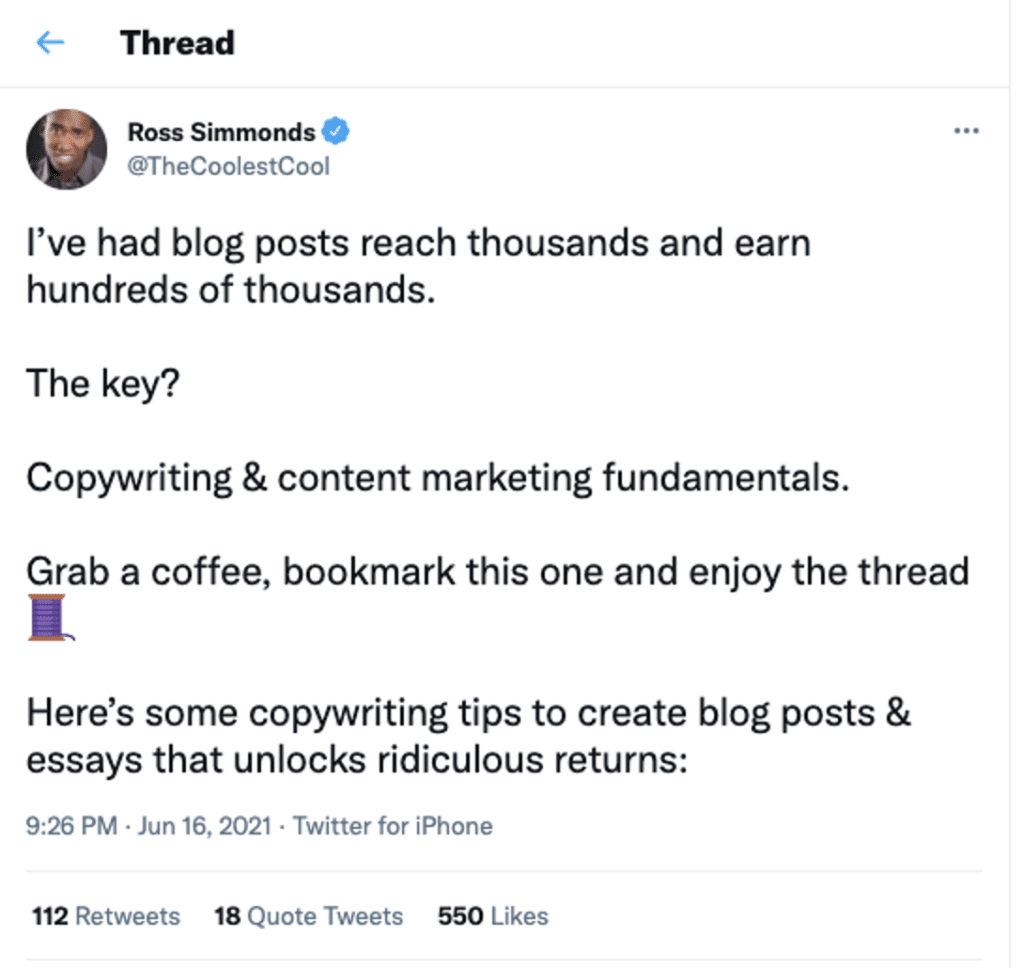
Sure, long-form content may work great for SEO, driving traffic from search results. But on social media, people want to consume content that is crisp and has takeaways.
And that’s where Twitter threads come into the picture. Foundation’s CEO Ross Simmonds has some of the most actionable Twitter threads for inspiration.
He also does a great job at breaking down the posts published on the Foundation blog into Twitter threads with key takeaways for the busy readers.
#9. Rework content for Instagram
While the general perception is that Instagram works great for B2C brands, many B2B brands have found success on this platform.
That means, even written content can find a home on a visual platform such as Instagram. However, instead of copy-pasting a paragraph as an Instagram post, think of pulling out salient data points or quotes and building a social narrative around it.
One of SproutSocial’s articles on social media manager’s mental health was well-received by the community and attracted a lot of page views. They converted this into an Instagram carousel with tips on how managers can discuss the subject of burnout with their team.
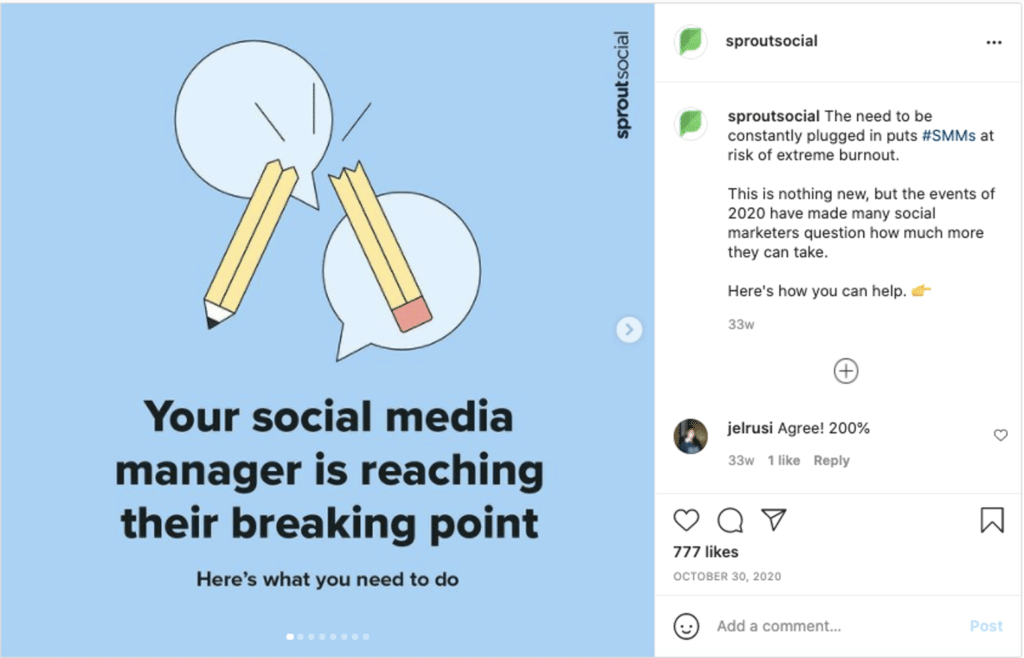
#10. Ask a question and provide an answer
Lastly, a no-brainer content repurposing trick for social media. The same questions you’ve used to spark comments at the end of a blog post or video can be reused for other platforms.
Twitter polls and LinkedIn Q&As are all opportunities to engage your audience with existing content or create a teaser for a new report.
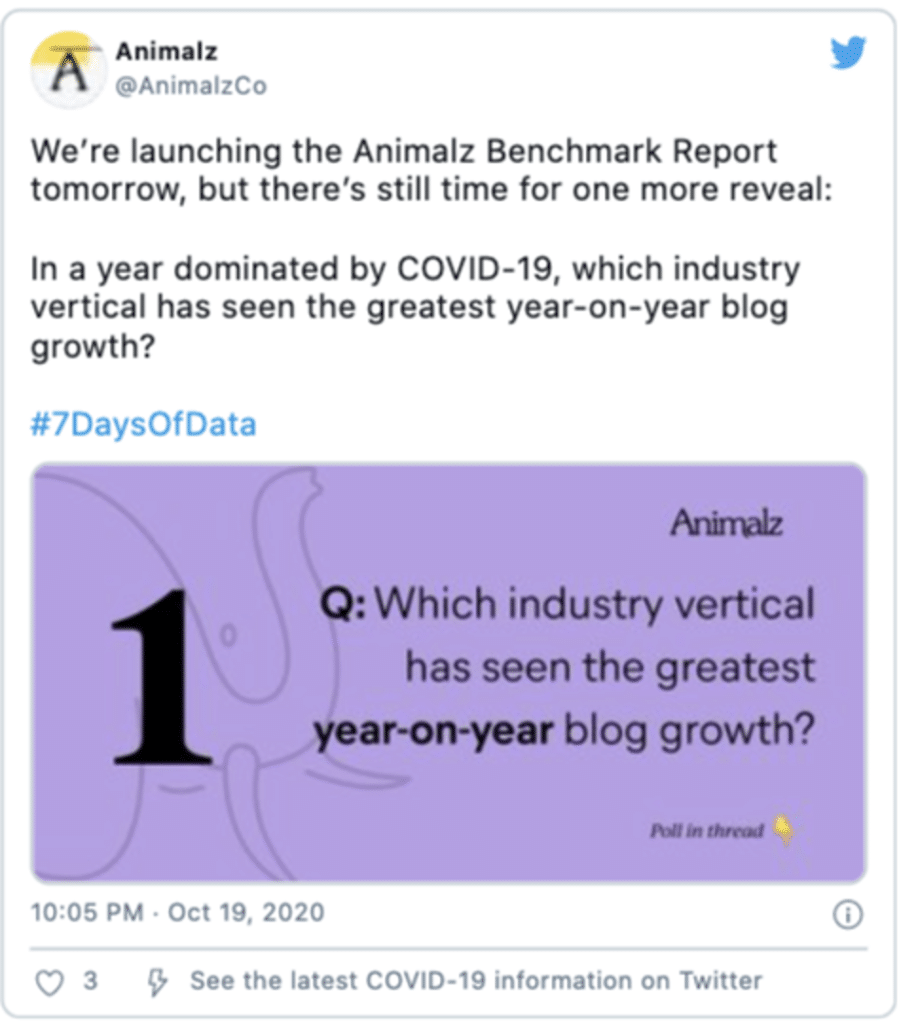
And then, search your LinkedIn, Quora, and Facebook communities for questions that you can answer with an existing article. A great way to build relationships and increase the chances of being found by others asking the same question is by repurposing content as your response to a query.
To increase audience participation, you can use the rewards and incentives tool Xoxoday Plum, which gives end-users instant and personalized incentives. Ranging from perks, experiences, utilities, wellness, and much more, the incentives are redeemable across 100+ countries.
Smart content repurposing gives exponential returns
If you have high-performing content, it is time to leverage it across social media channels. Using creative reformatting and thoughtful placement, social media marketers can make the most of their content assets and reduce the workload of social media content generation. A win-win for all.
About the author – Priyanka Desai is the founder of iScribblers, a content marketing and writing agency for technology, B2B, and SaaS companies. You can reach out to her on LinkedIn.

